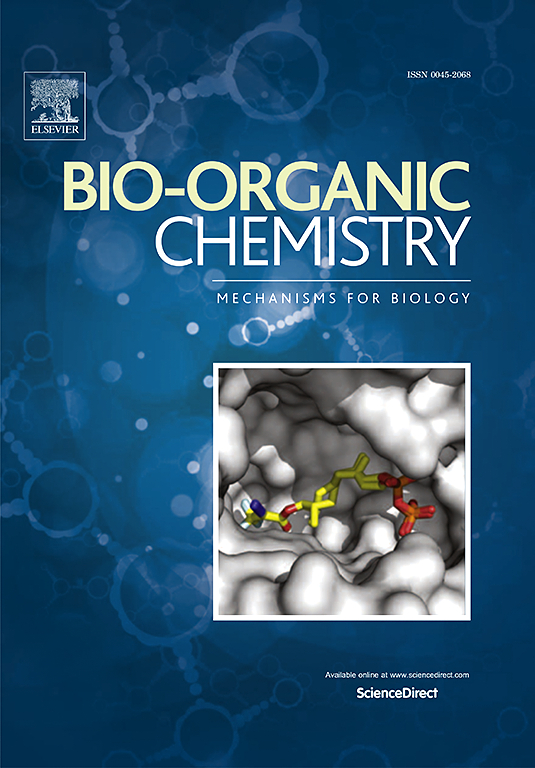Novel chalcone candidates as potential in vitro and in vivo anti-inflammatory agents: Synthesis, in silico docking, multitarget bioevaluation and molecular dynamic simulation
IF 4.5
2区 医学
Q1 BIOCHEMISTRY & MOLECULAR BIOLOGY
引用次数: 0
Abstract
Managing inflammation with the commonly used nonsteroidal anti-inflammatory drugs (NSAIDs) represents a critical challenge in modern medicine because of its strong influence on the cyclooxygenase-1 (COX-1) enzyme might induce substantial adverse effects. Therefore, there is urgent necessity for the exploration of safer alternatives, particularly cyclooxygenase-2 (COX-2) inhibitors. This study aimed to address this issue through the synthesis and evaluation of 19 new chalcone derivatives (2a-m and 4a-f) for their in vitro anti-inflammatory activity against various biotargets including iNOS, COX-2, 5-LOX, PGE2, and TNFα. Moreover, these compounds showed moderate to strong anti-inflammatory activity in the carrageenan rat paw edema test. Compounds 2a, 2f, 2 h, 2 m, and 4b are promising candidates for the treatment of inflammatory diseases. In particular, compound 4b was demonstrated to be the most effective derivative as a nitric oxide release inhibitor, exhibiting a 61.7 % inhibition rate. It exhibited substantial selectivity for COX-2 (IC50 = 1.933 μM) compared to COX-1 (IC50 = 5.526 μM). Compound 4b exhibited notable inhibitory activity against 5-LOX (IC50 = 2.112 μM) and demonstrated considerable inhibitory activity against iNOS, PGE2, and TNF-α biotargets in LPS-stimulated RAW cells, with IC50 values of 114.18, 37.13, and 58.15 nM, respectively. The in vivo anti-inflammatory effects demonstrated the significant efficacy of compound 4b, as evidenced by a notable edema inhibition rate of 37.05 %, along with minimal ulcerogenic activity observed in the histopathological findings. In silico experiments demonstrated that the intermolecular contacts of the most active chemical 4b with the biotargets COX-2, 5-LOX, and iNOS were analyzed by docking, revealing significant binding interactions. The stability of the interactions between compound 4b and the targets COX-2, 5-LOX, and iNOS was assessed using a standard 100 ns atomistic dynamic simulation method. Various parameters derived from MD simulation trajectories were adjusted and validated to confirm the stability of the generated complexes under dynamic settings. Ultimately, compound 4b exhibited favorable physicochemical properties and satisfactory drug-likeness, indicating its potential as an oral anti-inflammatory agent, warranting additional structure-activity relationship investigation and optimization.

新型查尔酮候选物作为潜在的体外和体内抗炎药:合成、硅对接、多靶点生物评价和分子动力学模拟
使用常用的非甾体抗炎药(NSAIDs)管理炎症是现代医学的一个关键挑战,因为它对环氧化酶-1 (COX-1)酶的强烈影响可能导致严重的不良反应。因此,迫切需要探索更安全的替代品,特别是环氧化酶-2 (COX-2)抑制剂。本研究旨在通过合成和评价19种新的查尔酮衍生物(2a-m和4a-f)对多种生物靶点(包括iNOS、COX-2、5-LOX、PGE2和tnf - α)的体外抗炎活性来解决这一问题。此外,这些化合物在卡拉胶大鼠足跖水肿试验中显示出中等至强的抗炎活性。化合物2a, 2f, 2h, 2m和4b是治疗炎症性疾病的有希望的候选者。其中,化合物4b是最有效的一氧化氮释放抑制剂,抑制率为61.7%。与COX-1 (IC50 = 5.526 μM)相比,它对COX-2 (IC50 = 1.933 μM)具有较高的选择性。化合物4b对5-LOX具有显著的抑制活性(IC50 = 2.112 μM),对lps刺激的RAW细胞中iNOS、PGE2和TNF-α生物靶点具有显著的抑制活性,IC50值分别为114.18、37.13和58.15 nM。体内抗炎作用证明了化合物4b的显著疗效,其水肿抑制率为37.05%,组织病理学结果显示其溃疡活性最小。硅实验表明,通过对接分析了最活跃的化学物质4b与生物靶标cox - 2,5 - lox和iNOS的分子间接触,揭示了显著的结合相互作用。采用标准的100 ns原子动力学模拟方法评估了化合物4b与靶标cox - 2,5 - lox和iNOS相互作用的稳定性。调整和验证了MD仿真轨迹的各种参数,以确认生成的配合物在动态设置下的稳定性。最终,化合物4b表现出良好的物理化学性质和令人满意的药物相似性,表明其作为口服抗炎药的潜力,需要进一步的构效关系研究和优化。
本文章由计算机程序翻译,如有差异,请以英文原文为准。
求助全文
约1分钟内获得全文
求助全文
来源期刊

Bioorganic Chemistry
生物-生化与分子生物学
CiteScore
9.70
自引率
3.90%
发文量
679
审稿时长
31 days
期刊介绍:
Bioorganic Chemistry publishes research that addresses biological questions at the molecular level, using organic chemistry and principles of physical organic chemistry. The scope of the journal covers a range of topics at the organic chemistry-biology interface, including: enzyme catalysis, biotransformation and enzyme inhibition; nucleic acids chemistry; medicinal chemistry; natural product chemistry, natural product synthesis and natural product biosynthesis; antimicrobial agents; lipid and peptide chemistry; biophysical chemistry; biological probes; bio-orthogonal chemistry and biomimetic chemistry.
For manuscripts dealing with synthetic bioactive compounds, the Journal requires that the molecular target of the compounds described must be known, and must be demonstrated experimentally in the manuscript. For studies involving natural products, if the molecular target is unknown, some data beyond simple cell-based toxicity studies to provide insight into the mechanism of action is required. Studies supported by molecular docking are welcome, but must be supported by experimental data. The Journal does not consider manuscripts that are purely theoretical or computational in nature.
The Journal publishes regular articles, short communications and reviews. Reviews are normally invited by Editors or Editorial Board members. Authors of unsolicited reviews should first contact an Editor or Editorial Board member to determine whether the proposed article is within the scope of the Journal.
 求助内容:
求助内容: 应助结果提醒方式:
应助结果提醒方式:


